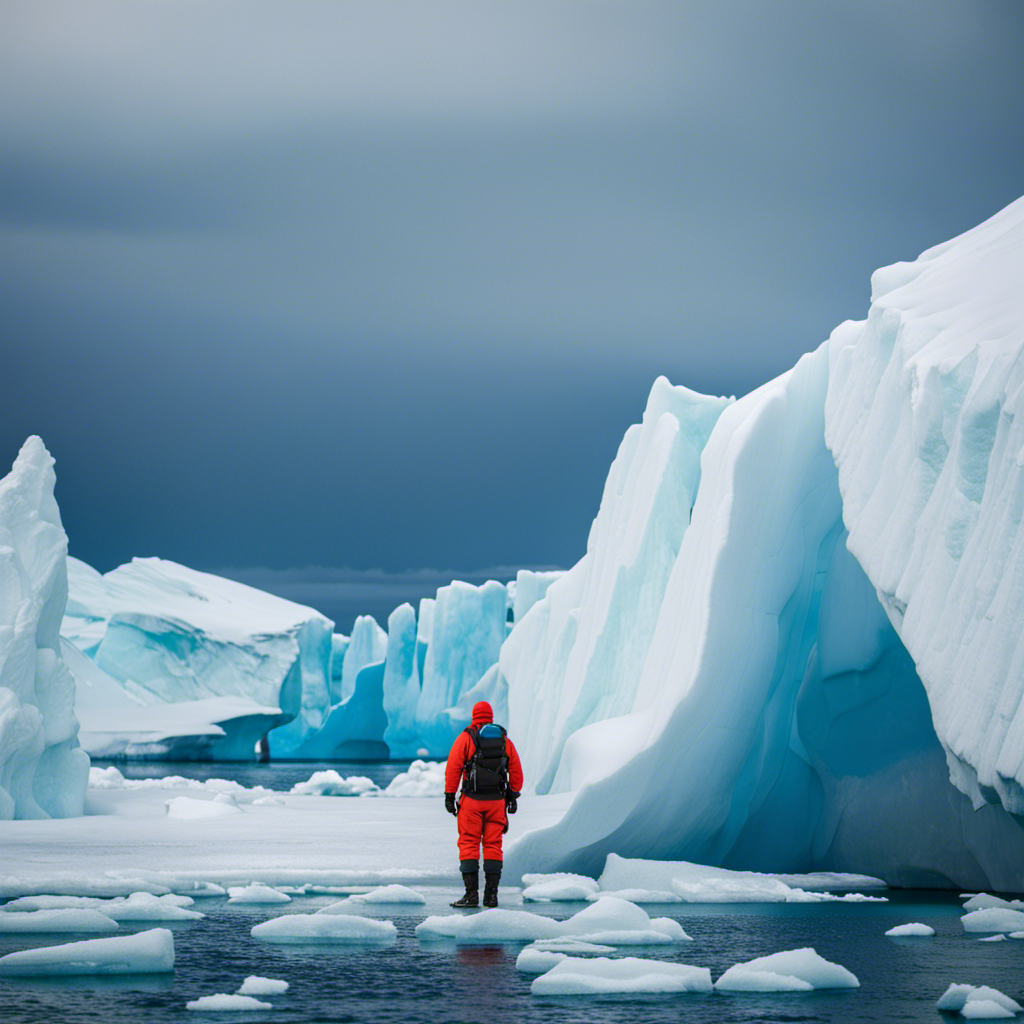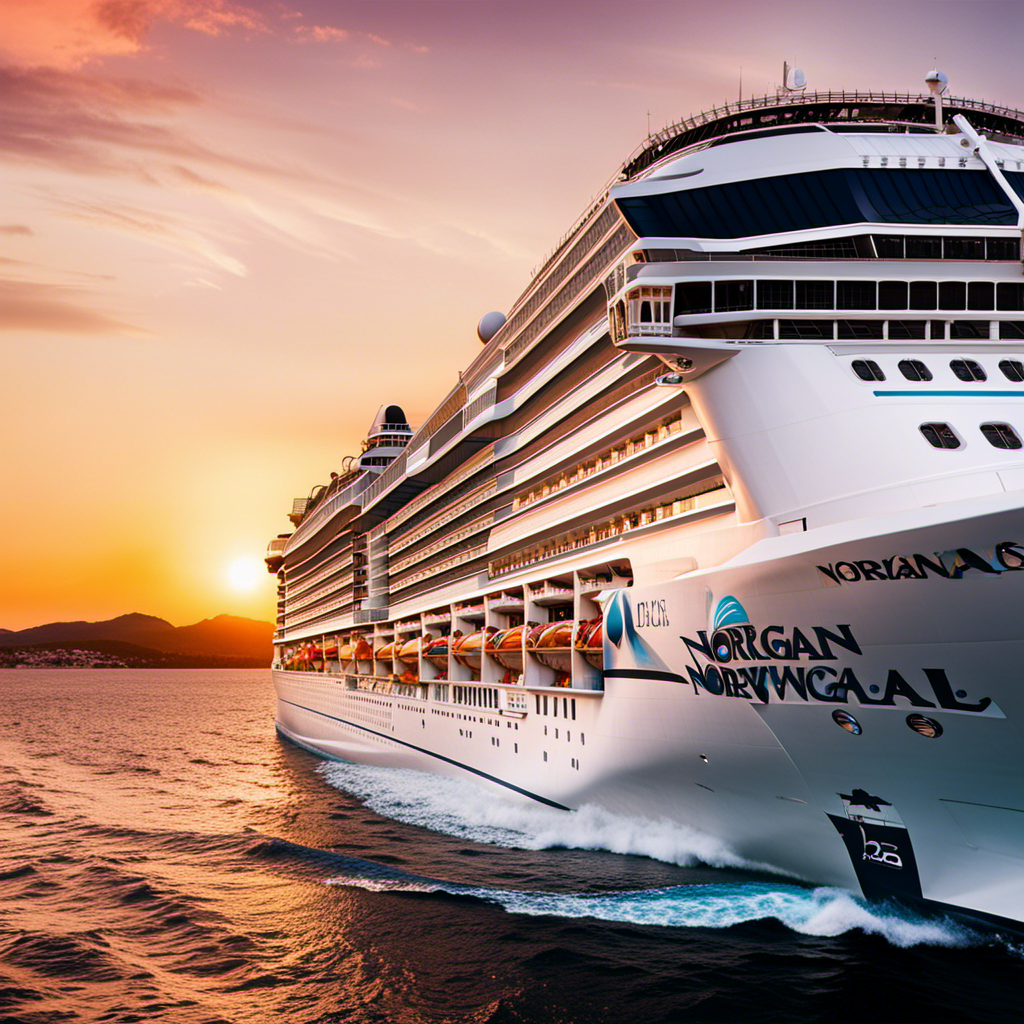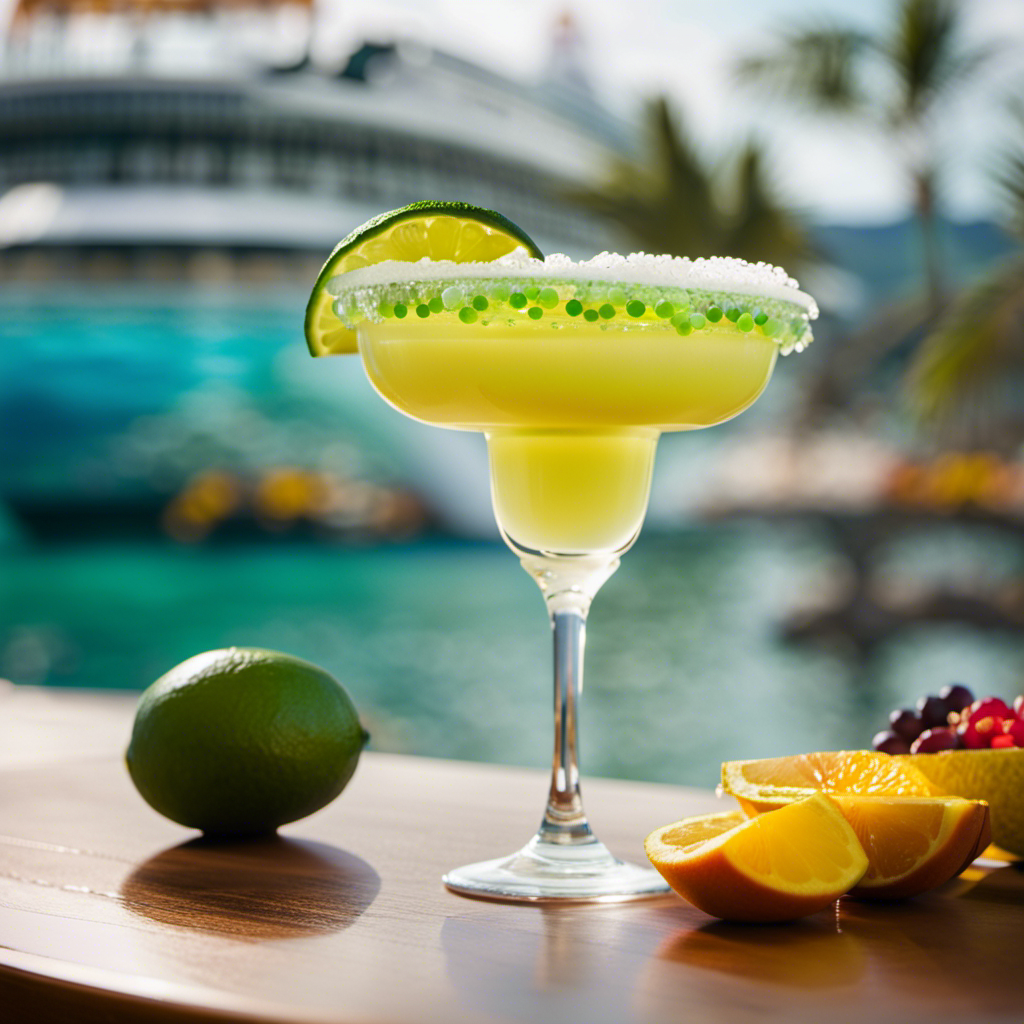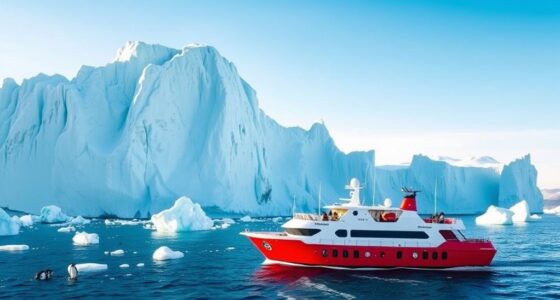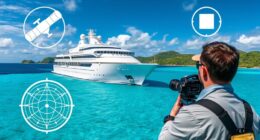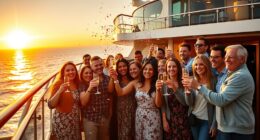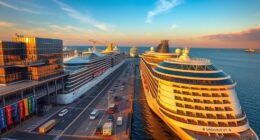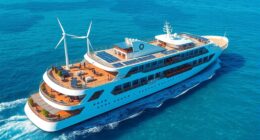The dream of exploring the 7th continent has always been close to my heart, and now, that dream is becoming a reality with an Antarctic cruise.
In this article, I’ll share essential tips I’ve gathered from my own experience to help you prepare for this incredible adventure. From packing the right clothing to taking advantage of expert lectures, we’ll cover everything you need to know.
So, grab your thermals and get ready for a journey like no other. Let’s dive into the world of Antarctica together!
Key Takeaways
- Attend lectures by expedition guides to learn about the polar regions and get a sneak preview of what you’ll see on landings
- Pack appropriate clothing for the Antarctic summer, avoiding cotton and opting for merino wool, silk, or polyester thermals
- Take advantage of the heated floors on the ship to dry clothes and warm up frozen fingers and toes
- Familiarize yourself with the lingo used by expedition leaders to better understand weather updates and conditions
Packing the Right Clothing
I should avoid packing cotton and opt for merino wool, silk, or polyester thermals for the Antarctic summer. These materials are better at keeping me warm and dry in the cold and potentially wet conditions.
When it comes to packing for an Antarctic cruise, it’s important to choose the right clothing. Base layers, wool socks, long-sleeved shirts, wool pants or synthetic leggings, and wool sweaters or non-cotton fleeces are all essential.
It’s also a good idea to bring a hat, gloves, scarf, and handwarmers for extra warmth. Additionally, don’t forget to pack a camera and a phone for photography. Capture the breathtaking beauty of the Antarctic landscape, both on and off the ship.
Keep your camera and phone protected in waterproof bags and remember to upload your whale tail photos to HappyWhale.com for identification. Don’t miss out on the opportunity to document this incredible journey.
Taking Advantage of Lectures by Experts
Attending lectures by expedition guides who are experts in polar regions allows me to gain valuable knowledge about krill, light-mantled sooty albatrosses, and Commandant Jean-Baptiste Charcot. These lectures provide a fascinating insight into the wildlife we will be exploring during our Antarctic cruise.
The guides, who include historians, marine biologists, ornithologists, military pilots, and researchers, share their expertise and experiences, bringing the history and significance of the region to life.
Learning about the incredible biodiversity of krill and the unique characteristics of the light-mantled sooty albatrosses helps us appreciate the delicate balance of the ecosystem we are about to encounter.
Understanding the historical expeditions led by Commandant Jean-Baptiste Charcot adds an extra layer of depth to our journey, making it even more meaningful.
It is through these lectures that we can truly immerse ourselves in the wonders of Antarctica.
Enjoying the Luxury of Heated Floors
Experiencing the luxury of heated floors on the ship provides a cozy and comfortable environment for drying clothes and warming up after exploring in the cold. The bathroom floors are heated, allowing you to conveniently dry your damp clothes. Simply lay them out on the warm floor and they’ll be dry in no time. It’s a lifesaver when you come back from a wet landing or a Zodiac ride.
Additionally, the heated floors are a welcome treat for your frozen fingers and toes. Before heading out, make sure to turn on the heated floors so that they’re nice and toasty when you return.
And if you really want to indulge, each cabin also comes with its own private sauna. So after a long day of adventure, you can relax and unwind in the warmth of your own personal sauna. It’s the ultimate luxury in the Antarctic.
Understanding the Language of Expedition Leaders
Learning the lingo used by expedition leaders enhances my understanding of weather updates and ensures I am well-prepared for rough conditions at sea. It’s like having my own personal code to decipher the ever-changing elements of the Antarctic.
Here are three key terms I’ve come to know and their meanings:
-
‘Sporty’ – This is the expedition leader’s way of warning us about rough weather conditions. It’s a signal to prepare for strong winds, big waves, and the need for extra caution.
-
‘Fresh’ – When the expedition leader mentions this term, it means that we can expect cold temperatures. It’s a reminder to bundle up and stay warm.
-
‘Whipping’ – This term describes the presence of strong winds and waves. It’s a sign that we should be prepared for a bumpy ride and secure any loose items.
Understanding these expedition leader terminologies not only helps me navigate the weather updates but also gives me peace of mind as I cope with seasickness. By knowing what to expect, I can better prepare myself physically and mentally for the challenges that may arise during the voyage.
Bracing for High Seas and Rough Weather
I pack my bags with sturdy clothing and remedies for seasickness, knowing that high seas and rough weather are expected during the voyage. The notorious Drake Passage can bring waves of more than 25 feet, making it challenging for some travelers. To combat seasickness, some opt for prescription scopolamine patches. These patches, worn behind the ear, release medication that helps prevent nausea. Other remedies include green apples, Bonine, ginger beer, and focusing on the observation lounge. As someone who has experienced rough seas, I can attest to the effectiveness of these remedies. It’s important to watch the horizon and keep yourself fed to prevent seasickness. With these precautions in mind, you’ll be better equipped to handle the high seas and rough weather during your Antarctic cruise.
| Seasickness Remedies | Effectiveness | Method of Use |
|---|---|---|
| Scopolamine patches | Highly effective | Apply behind the ear and replace every 3 days |
| Green apples | Mildly effective | Eat a slice when feeling nauseous |
| Bonine | Moderately effective | Take one tablet before boarding the ship |
| Ginger beer | Moderately effective | Sip slowly to ease nausea |
| Focusing on the observation lounge | Moderately effective | Find a comfortable spot and focus on the horizon |
Mastering the Art of Antarctic Photography
Capturing breathtaking images of wildlife and stunning landscapes is an art that can be mastered during an Antarctic voyage. The unique opportunity to explore the seventh continent provides endless possibilities for photographers.
From underwater exploration to close wildlife encounters, there is no shortage of subjects to capture. The crystal-clear waters of Antarctica offer a glimpse into an enchanting world beneath the surface. With proper equipment and guidance, photographers can capture mesmerizing shots of penguins, seals, and even whales in their natural habitat.
On land, the majestic landscapes of icebergs, glaciers, and snow-covered mountains create a stunning backdrop for wildlife photography. It takes patience and a keen eye to capture the perfect moment, but the results are truly extraordinary.
A journey to Antarctica is a photographer’s dream come true, offering endless opportunities to showcase the beauty of this remote and untouched wilderness.
Making the Most of Zodiac Rides
After mastering the art of Antarctic photography, another essential aspect of exploring the seventh continent is making the most of Zodiac rides.
These small, inflatable boats are essential for getting up close and personal with the wildlife and breathtaking landscapes of Antarctica.
To maximize wildlife sightings during these rides, it is important to listen to the guidance of your experienced expedition guides. They will know the best spots to encounter penguins, seals, and whales.
Additionally, it is crucial to follow safety precautions during Zodiac rides. Always wear a life jacket and adhere to the instructions provided by your guide. Be mindful of the boat’s weight distribution and avoid making sudden movements that could tip the boat.
Protecting Your Camera and Phone From Water Damage
To safeguard my camera and phone from water damage while exploring Antarctica, I’ll ensure they are stored in waterproof bags during Zodiac rides. It’s crucial to protect these valuable pieces of equipment, especially the camera lens, which can be easily damaged by water.
Here are some tips for protecting your camera and phone:
-
Use waterproof bags: Invest in high-quality waterproof bags specifically designed for cameras and phones. These bags provide a protective barrier against water, ensuring your devices stay dry during Zodiac rides.
-
Double protection: Consider using a Ziploc bag as an extra layer of protection for your phone. This will provide an additional safeguard against water damage.
-
Secure storage: Make sure to secure the waterproof bags properly to prevent any accidental drops or exposure to water.
Contributing to Whale Research With Happywhale.Com
When exploring the 7th continent, capturing breathtaking photographs is a must. Not only can you document your incredible journey, but you can also contribute to whale research through HappyWhale.com. This innovative platform allows you to upload your whale tail photos, which are then used to identify individual whales and track their movements. It’s a fantastic way to actively participate in scientific research while enjoying your Antarctic adventure.
To make the most of your photography, remember to bring both a camera and a phone. Keep your camera in a waterproof bag and use a Ziploc bag for your phone to protect them from water damage. Capture the best shots off the ship, even during exciting Zodiac rides. And don’t forget to record videos with sound to capture the unique sounds of your Antarctic voyage.
Your photographs and recordings could potentially contribute valuable data to ongoing whale research efforts. So, snap away and make a difference in the world of marine science!
Capturing the Unique Sounds of an Antarctic Voyage
I can record videos with sound to capture the unique sounds of my Antarctic voyage. It’s an incredible opportunity to capture the sounds of this remote and pristine environment.
Here are some tips for capturing sounds and contributing to whale research:
- Find a quiet spot on the ship to record the sounds of the waves, ice cracking, and the distant calls of wildlife.
- Use a good quality microphone or a smartphone with a recording app to capture the sounds clearly.
- Listen for the distinctive songs and calls of whales during your Zodiac rides or from the deck of the ship.
- Upload your recordings to HappyWhale.com, a platform that helps scientists identify and track individual whales.
- By contributing your recordings, you can help researchers learn more about whale behavior and population dynamics.
Capturing these sounds not only allows you to relive your Antarctic adventure, but also contributes to important scientific research on marine life. So don’t forget to pack your recording equipment and be ready to capture the incredible sounds of your journey!
Frequently Asked Questions
Is There a Dress Code for the Lectures by Experts on the Cruise?
Yes, there is a dress code for the lectures on the cruise. It’s best to pack appropriate clothing for the Antarctic summer, such as merino wool, silk, or polyester thermals. Avoid cotton.
How Can I Make the Most of the Heated Floors in My Cabin?
To maximize cabin comfort, I recommend using the heated floors to dry clothes and warm up. Turn them on before heading out and enjoy your own private sauna. They take over an hour to reach full temperature.
Are There Any Specific Tips for Understanding and Communicating With Expedition Leaders?
To build rapport with expedition leaders and communicate effectively in remote environments, listen attentively, ask questions, and show genuine interest. Use their lingo and familiarize yourself with weather terms for better understanding.
What Are Some Effective Remedies for Seasickness During the Cruise?
For seasickness remedies during the cruise, try prescription scopolamine patches or natural remedies like green apples, Bonine, and ginger beer. As for dress code for lectures, pack appropriate clothing like merino wool thermals and non-cotton fleeces.
Are There Any Recommended Techniques for Capturing the Unique Sounds of an Antarctic Voyage With a Camera or Phone?
Capturing the unique sounds of an Antarctic voyage is a must. To do so, use your camera or phone to record videos with sound. It’s a great way to preserve the memories of this incredible experience.

